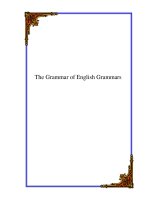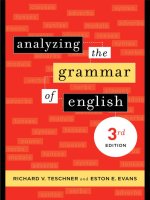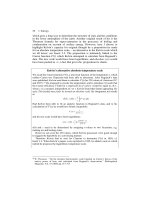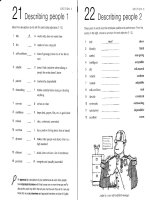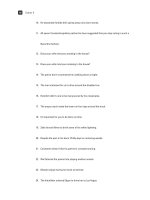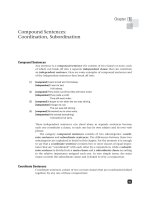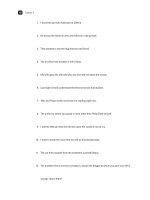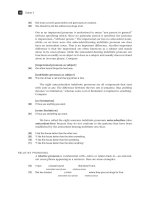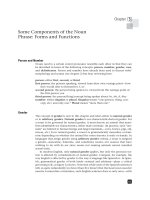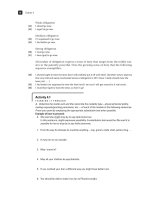Analyzing the Grammar of English Third Edition phần 3 pptx
Bạn đang xem bản rút gọn của tài liệu. Xem và tải ngay bản đầy đủ của tài liệu tại đây (252.2 KB, 24 trang )
35
(2) three different vowel sounds:
fly:
fly (base)
flew (past)
flown (past participle)
Three highly frequent five-form verbs—do, go, have—do not conform to any of
these patterns and must be treated individually as eccentrics. (Phonetic transcrip-
tion and commentary is added.)
do:
do [du] (base)
did [did] (past) (ablauting but /d/ regularity)
done [dn] (past participle) (ablauting with -n)
go:
go [go] (base)
went (past) (went is phonetically unrelatable to the verb’s base),
gone [gɔn] (past participle) (ablauting; -n addition)
have:
have [hæv] (base)
had [hæd] (past and past participle) (no ablauting; the base
form’s consonant [v] is deleted, thus: *[hævd] → [hæd])
Activity 2.1
THINKING IT THROUGH
A. Give the past and the past participle forms for each of these verbs. Then tell whether the
verb is regular or irregular, and, if irregular, which of the nine irregular verbs it behaves like.
Example of how to proceed:
X. take: took, taken; irregular; conforms to the pattern of eat
The Nine Morphological Patterns of Irregular Verbs
1. become
2. blink
3. bring
4. call
5. cost
6. dig
7. drown
8. fall
9. have
10. hear
11. hold
12. injure
13. know
14. leave
15. lend
16. let
17. lie [two answers]
18. make
031-054.Teschner.02.indd 35031-054.Teschner.02.indd 35 4/2/07 6:06:46 PM4/2/07 6:06:46 PM
Chapter 2
36
19. mean
20. milk
21. need
22. read
23. ride
24. ring
25. see
26. sell
27. send
28. shake
29. sleep
30. slide
31. spring
32. steal
33. strike
34. sweep
35. swim
36. take
37. teach
38. tear [something]
39. tell
40. think
41. transcribe
42. try
43. wear
44. weep
45. welcome
46. win
47. wring
48. write
1. gave
2. led
3. smile
4. given
5. hid
6. ridden
7. rode
8. blew
9. paid
10. taken
11. put
12. ring
13. rang
14. thrown
15. swung
16. sought
17. cut
18. came
B. Tell whether each of the following forms is base, past, past participle, or two or more of
these classifications simultaneously (and, if so, which).
031-054.Teschner.02.indd 36031-054.Teschner.02.indd 36 4/2/07 6:06:48 PM4/2/07 6:06:48 PM
37
19. decide
20. done
21. missed
22. blown
23. stank
24. went
25. tune
26. founded
27. drove
28. got
29. bring
30. woven
The Nine Morphological Patterns of Irregular Verbs
WRITING IT OUT
C. Use, as verbs, each of the following verb forms in a sentence. Write the sentence to the
right of the verb form.
1. answered
2. bet
3. caught
4. dealt
5. enjoying
6. fought
7. got
8. held
9. insist
10. jokes
11. kept
12. lie
13. made
14. nudged
15. obeys
16. put
17. quit
031-054.Teschner.02.indd 37031-054.Teschner.02.indd 37 4/2/07 6:06:49 PM4/2/07 6:06:49 PM
Chapter 2
38
18. rode
19. shrank
20. threw
21. up
22. voting
23. worn
24. xerox
25. yoke
26. zero
Verb Tenses and Auxiliary Verbs: The Nonmodal Auxiliaries
(Do, Be, Have) and the Modal Auxiliaries
THE SIMPLE TENSES
In a simple tense, the verb phrase consists of just one word—the conjugated verb
form (cvf) of the LV. If the verb phrase consists of more than one word—the cvf
plus a participle (past or present)—the tense it contains is a compound tense,
not a simple tense. English has only two genuinely simple tenses: present and
past. The morphology of the simple tenses’ verb forms has already been exam-
ined, so we’ll give only a quick review of a regular verb—call—in conjugation:
The regular verb call in simple-tense conjugation
Present tense:
person (؍ subject) singular plural
1st (the person(s) speaking) I call we call
2nd (person(s) spoken to) you call you call
3rd (person(s) spoken about) he
she
⎧
⎨
⎩
calls they call
it
Past tense:
1st I called we called
2nd you called you called
3rd he
she
⎧
⎨
⎩
called they called
it
THE IMPORTANCE OF THE SUBJECT
Conjugating a verb in the same tense is a mainly irrelevant exercise in a language
like English where the vast majority of verbs, including many irregular ones,
031-054.Teschner.02.indd 38031-054.Teschner.02.indd 38 4/2/07 6:06:51 PM4/2/07 6:06:51 PM
39
have four forms only. This is shown by the repetition in the above chart with
just three different words (call, calls, called) in a total of twelve separate slots or
positions. It is this repetition of cvf that makes English so reluctant to drop its
subject pronouns from the surface of the sentence as so many other languages
have done. The following is ungrammatical for precisely that reason.
[1] *Anyway, told me to pay but said that couldn’t.
A grammatical version would have to read:
[2] Anyway, he told me to pay but I said that I couldn’t.
With few exceptions, all verbs in English require a subject to appear in the
surface structure, that is, in a construction’s final spoken or written product (cf.
its deep structure [the representation of the elements that underlie the surface
structure]). Without a surface subject, most English verb forms do not tell us, for
example, who or what is doing the action, assuming the state, or constituting the
subject noun linked by equation to the predicate noun.
IMPERATIVES, THE PRESENT TENSE, AND THE EXCLUDED SUBJECT PRONOUN
Only present tense forms can be used in imperatives (direct command forms,
used in communicating an order) because one can only command someone to do
something “now” (at the present moment), not “then” (at some past moment).
(Thus Stop doing that! but never *Stopped doing that!) Likewise, only second per-
son pronouns can serve as the (implied) subject of an imperative construction
because a direct command can only be directed at someone we are speaking to,
not someone we are speaking about.
4
Direct commands typically exclude from
the surface structure their implied (or underlying) subject pronoun you—
[3] Come inside right now!
[4] Play nicely with the other children.
[5] Please sit here.
But the you can be reinstated at will, often to make the command more emphatic
or forceful, thus:
[6] You come inside right now!
[7] Now you play nicely with the other children, you hear?!
THE COMPOUND TENSES: PRESENT AND PAST
As noted above, a compound tense is one in which each verb phrase consists
of at least two words. (Thus have called or have been calling are compound tenses
whereas call is a simple tense.) There are two main types of present or past com-
pound tenses: perfect and progressive. A third type—perfect progressive—com-
bines the two. (Note that only the active voice is being treated in this chapter.
The passive voice tenses will be discussed in chapter 4. All passive voice tenses
are compounds.)
Present perfect and past perfect tenses consist of two elements: a conjugated
form of the nonmodal auxiliary verb have plus the past participle of the lexical
Verb Tenses and Auxiliary Verbs: The Nonmodal Auxiliaries (Do, Be, Have) and the Modal Auxiliaries
031-054.Teschner.02.indd 39031-054.Teschner.02.indd 39 4/2/07 6:06:53 PM4/2/07 6:06:53 PM
Chapter 2
40
verb in question. Since have is conjugated, have is marked for person, number,
and tense, while the past participle is never conjugated and is therefore never
marked for person/number/tense. Thus have changes form while the past parti-
ciple does not.
What follow are several examples of the present perfect and the past perfect
tenses:
Present Perfect Past Perfect
[8] We have eaten enough. [9] We had eaten enough.
present tense of past part. of past tense of the past part. of
nonmodal aux have the LV eat nonmodal auxiliary have the LV eat
[10] She has talked to him before. [11] She had talked to him before.
[12] They have been very busy. [13] They had been very busy.
Present progressive and past progressive tenses also consist of two words: a
conjugated form of the nonmodal auxiliary verb be plus the (never conjugated)
present participle of the particular LV. Here are some examples:
Present Progressive Past Progressive
[14] We are just killing time. [15] I was just killing time.
present tense of present part. past tense of present part.
nonmodal aux of LV kill BE nonmodal aux of LV kill BE
Compound tenses consisting of three words are the present perfect progres-
sive and the past perfect progressive. The three words are these:
a conjugated form of the nonmodal auxiliary have been (the past participle
of BE)
the present participle of the particular LV
Here are some examples of these two perfect progressive tenses:
Present Perfect Progressive
[16] We have been eating fish.
pres. tense of have past part. of BE pres. part. of LV eat
Past Perfect Progressive
[17] We had been eating fish.
past tense of have past part. of BE pres. part. of LV eat
The Compound Tenses: Future and Conditional
It is important to be aware that the English tenses normally labeled “future” and
“conditional” are themselves compounds, not simple tenses as are their equiva-
lents in languages such as Spanish, French, Portuguese, and Italian. The English
future tense consists of the modal auxiliary will plus the particular LV’s base
form, thus:
031-054.Teschner.02.indd 40031-054.Teschner.02.indd 40 4/2/07 6:06:55 PM4/2/07 6:06:55 PM
41
Future tense
[18] She will speak to them soon.
modal aux will base form of LV speak
The construction that we call (for the sake of convenience) the conditional tense
consists of the modal auxiliary would plus the LV’s base form, thus:
Conditional tense
[19] If she chose, she would speak to them right away.
modal aux would base form of LV speak
The conditional form—the modal auxiliary would plus the LV’s base form—has
at least three functions: (1) true conditionality, (2) future-in-the-past, and
(3) habitual action (or state) in the past. The true conditionality function is
treated extensively at the end of chapter 4 and can be illustrated here by the fol-
lowing sentence:
[20] If I had any money I would buy a new car.
The future-in-the-past function of the conditional form is exemplified by sen-
tences such as (21):
[21] He said he would leave at midnight.
Sentence (21) is simply a past tense version of (22):
[22] He says he will leave at midnight.
And the habitual action in the past function is illustrated by (23):
[23] Back then, he would arrive at 10 and stay all day.
The future and conditional constructions with will and would, respectively, are
often referred to as the synthetic future tense and the synthetic conditional
tense, terms that explicitly contrast these two tenses with the periphrastic
future tense and the periphrastic conditional tense. In the periphrastic con-
structions, use is made of the semi-auxiliary perimodal phrase BE going to (in
which BE is the conjugated element) to express certain types of futurity or condi-
tionality. Here are some examples of the periphrastic future and the periphrastic
“conditional”:
5
Periphrastic Future Periphrastic “Conditional”
[24] I am going to leave soon. [25] I was going to leave soon.
[26] They are going to pass. [27] They were going to pass.
Whereas the two periphrastic tenses are said to give the impression of immi-
nence and certainty (that something is just about to happen), the synthetic
tenses supposedly imply a more remote prediction. At times, however, the dif-
ference between the impressions that each set gives is largely stylistic, with the
The Compound Tenses: Future and Conditional
031-054.Teschner.02.indd 41031-054.Teschner.02.indd 41 4/2/07 6:06:57 PM4/2/07 6:06:57 PM
Chapter 2
42
periphrastic tenses preferred in informal and colloquial speech and the synthetic
tenses used in more formal language.
Both the synthetic future-marking modal will and the synthetic conditional-
marking modal would combine with forms of the nonmodal auxiliaries have and
be to produce future or conditional perfect, future or conditional progressive,
and future or conditional perfect progressive tenses for a total of six additional
compound tenses. Here are some examples of these six additional tenses:
The futures
future perfect
[28] She will have spoken to him by this time tomorrow.
future progressive
[29] She will be speaking to him soon.
future perfect progressive
[30] She will have been speaking to him for an hour by this time tomorrow.
The conditionals
conditional perfect
[31] She would have spoken to him if she could.
conditional progressive
[32] She would be speaking to him now if he were here.
conditional perfect progressive
[33] She would have been speaking to me now if I had let her.
When we add these six tenses to the eight above, we arrive at fourteen active-
voice compound tenses. Figure 2a encapsulates all fourteen. (The figure includes
parenthetical space for the only tenses—the present and the past—that are not
compound but simple, as we already know.)
“Simples” Perfects Progressives Perfect Progressives
futures future future perfect future
progressive
future perfect
progressive
I will talk I will have talked I will be talking I will have been talking
conditionals condi-
tional
conditional
perfect
conditional
progressive
conditional perfect
progressive
I would talk I would have
talked
I would be talking I would have been talking
presents (present) present perfect present
progressive
present perfect
progressive
(I talk) I have talked I am talking I have been talking
pasts (past) past perfect past progressive past perfect progressive
(I talked) I have talked I was talking I had been talking
Figure 2a The Fourteen Active Voice Compound (and the Two Simple) Verb Tenses
031-054.Teschner.02.indd 42031-054.Teschner.02.indd 42 4/2/07 6:06:59 PM4/2/07 6:06:59 PM
43
Activity 2.2
THINKING IT THROUGH
A. Underline each of the simple or compound verb tenses appearing below, then give the
name of each one’s tense. Note that some of the verb forms will appear as infinitives, that is,
without tense (tenseless).
Example of how to proceed:
X. “He has always wanted to marry me.” Has wanted is the present perfect tense.
1. I have told you what I think about him.
2. They are refusing to cross the picket line.
3. What has become of Baby Jane?
4. Many have called but few have answered.
5. I had been searching for them since Monday.
6. In all likelihood they will have left by now.
7. I just get so upset; I just don’t know.
8. All my friends were there and gave me presents.
9. We will obey your orders.
10. They wouldn’t have been staying at grandma’s house because she went to the cabin to
prepare for the weekend.
11. You said you’d be coming in on the six o’clock flight.
12. He is taller than I was at that age.
13. I would have written you if I had found the time.
14. They know what I did.
15. He went out and got some bread.
16. By the end of 2009, Vince will have been teaching for forty years.
17. She’s going to buy me a peanut butter and jelly sandwich.
18. She said she would meet me on the terrace at noon.
19. I have been looking for you all my life.
20. They were going to tell us they had already disposed of the body.
The Compound Tenses: Future and Conditional
031-054.Teschner.02.indd 43031-054.Teschner.02.indd 43 4/2/07 6:07:01 PM4/2/07 6:07:01 PM
Chapter 2
44
WRITING IT OUT
B. Write three sentences that use the same tenses and structures as each of the following.
Example of how to proceed:
X. She will have been sitting on top of the flagpole for fourteen hours when she finally falls
off of it. “You could write, for example: They will have been running around the race
track for seven hours when they finally collapse from exhaustion.”
1. I am enjoying every minute of my trip to Lower Slobovia.
2. They have never eaten as many hot dogs as they ate today.
3. He promised her that he would climb every mountain in Iowa.
4. The big brown cow had been feeling sick for several days.
5. The cowboy was running around and acting like a total fool.
6. I would have married you if you had wanted me to do so.
7. We surely were the biggest fools that anyone had ever seen.
8. I promise I will write you every day that I am on the road.
C. Write a sentence containing a verb form that corresponds to each of these descriptions.
Use any LV, person, and number.
1. present
2. past progressive
3. synthetic future
031-054.Teschner.02.indd 44031-054.Teschner.02.indd 44 4/2/07 6:07:02 PM4/2/07 6:07:02 PM
45
4. periphrastic future
5. synthetic conditional
6. periphrastic conditional
7. future perfect
8. past perfect
9. future perfect progressive
10. past
11. present perfect
12. present progressive
13. conditional perfect
14. conditional progressive
15. future progressive
Verb Tenses’ Meanings and Uses
The following six sections provide information about how the various tenses’
forms are used in differing functions to convey separate meanings and what
sorts of meaning they convey. The distinction between form and function is a
very important one. Form is the physical shape of a word itself—the phonemes
and morphemes that it contains and how these phonemes and morphemes
contrast with other words’ phonemes and morphemes. Thus the difference in
form between words such as break and broken can be described phonologically:
“/brek/ vs. /brókən/—monosyllabic /brek/’s vowel is mid front tense and its
final consonant is /k/, but bisyllabic /brókən/’s stressed vowel is mid back tense,
its unstressed vowel is schwa, and its final consonant is /n/”. The break/broken
Verb Tenses’ Meanings and Uses
031-054.Teschner.02.indd 45031-054.Teschner.02.indd 45 4/2/07 6:07:03 PM4/2/07 6:07:03 PM
Chapter 2
46
difference can also be described morphologically: “break is this verb’s base form
and broken is its past participle, whose /ən—same morpheme /ən/ that appears
on other irregular forms such as given, eaten, written, and ridden—marks forms like
these as past participles.”
Function on the other hand refers to the meaning that different forms con-
vey when they are used in different contexts. Therefore (and as we’ll see in detail
in the very next section)—the forms of the English present tense are said to have
different functions because in one context they tell us that the action is tak-
ing place in the present moment, while in another context they tell us that the
action will take place in the future as an unscheduled event.
Throughout our discussion of form and function we will contrast tense (a
form topic—this focuses on the verb forms’ shapes and the form-based categories
they belong to) with time (a function topic—among other things, this refers to
time as it can be told on a chronological scale: the immediate moment in the
present right now, the future yet to come, the immediate past of a minute or an
hour ago, the more remote past of several weeks, months, years, decades, or cen-
turies ago, and so forth).
THE PRESENT TENSE
The forms of the present tense—an overworked tense in English—can function
in reference to the present time, to the future time, and even in a limited way
to the past time. In its present time function, the present tense conveys the
following meanings:
a. It makes reference to the actual present moment, what is happening at this
very point in time—a function that is actually more typical of the present
progressive tense (see below) than of the present tense. This present moment
reference will often involve someone’s describing what someone else is doing
right this instant, as in, for example, an opera broadcast:
[34] Maddalena falls into the arms of don Vincenzo and swears eternal love even as he plunges the
dagger deep into her treacherous heart while she breathes her dying breath. She now expires,
and Vincenzo begins to sob uncontrollably as the curtain falls on the final act of Massimo
Verismo’s La forza delle putane.
b. It makes reference to an ongoing stretch of time involving a stative verb, one
that denotes states of being or states of possessing (as opposed to actions). It’s
obvious that in stative functions the being or possession is part of the present
moment (and will likely be part of the future as well), but it is also true that
the “state” came to be sometime in the past. Examples:
[35] Saul has five income properties on the north side of Chicago. [He bought them in 1963, he contin-
ues to own them today, and he’s likely to own them for several more years to come.]
[36] She knows the names and capitals of all the world’s 196 countries. [She learned them ten years
ago, she recalls them now, and she’s likely to keep them in mind for the rest of her days.]
c. It makes reference to an ongoing stretch of time involving a durative verb,
one whose action—typically repeated again and again to the point that it
031-054.Teschner.02.indd 46031-054.Teschner.02.indd 46 4/2/07 6:07:05 PM4/2/07 6:07:05 PM
47
becomes habitual—is even less closely tied to the present moment than is a
stative’s. Examples:
[37] By day he gambles and by night he drinks and carries on.
[38] On the other hand, you read too much, work too fast, and study too hard.
d. It makes reference to a fraternal twin of both statives and duratives known as
the timeless truth, which refers to something that will never change unless
the world comes to an end:
[39] Tierra del Fuego is near Antarctica.
[40] The Andes Mountains run the length of the South American continent.
[41] Three constitutes the square root of nine.
e. It makes reference to what becomes a reality by virtue of its being said the
instant it is said—the so-called performative verb, in which when you say
the words you perform the action, thus making it real. Examples:
[42] I now pronounce you man and wife. [The minute the official pronounces the words man and wife,
the couple has entered the married state.]
[43] Here is where the judge sentences him to life in prison.
[44] The priest always blesses the new couple’s union at the end of the mass.
[45] I hereby declare this woman insane.
In its future time function, the present tense is employed for these two purposes:
a. to refer to events that are scheduled or planned on, for example:
[46] The hunger strike begins tomorrow at dawn.
[47] The ship leaves the dock at 1 p.m. on Friday, November 13th.
Note that if the event is not scheduled or planned, the present tense will
not be used to express future time usage, and the synthetic or periphrastic
future—or an infinitive complement—will appear instead. Example:
[48] *Do you promise you bring me back something from Hawaii, Daddy?
→→→ Do you promise you will bring me back . . .
or: Do you promise you are going to bring me back . . .
or: Do you promise to bring me back . . .
b. to refer to an unscheduled future event in a subordinate clause of a sentence
whose main clause is in the future tense:
[49] I’ll pay you back when the check arrives.
main clause subordinate clause
[50] She will turn you in to the cops as soon as she finds the smoking gun.
main clause subordinate clause
Verb Tenses’ Meanings and Uses
031-054.Teschner.02.indd 47031-054.Teschner.02.indd 47 4/2/07 6:07:06 PM4/2/07 6:07:06 PM
Chapter 2
48
In its past time function, the present tense’s sole role—and it is a very limited
one—is to narrate the so-called “historical present” whereby the past is made more
immediate and vivid when it is brought forward into the present. Example:
[51] I once murdered someone. It was a dark and stormy night. I was walking down Broadway when all
of a sudden this drunk falls out of a doorway, staggers, sticks his hand in his mouth and starts
to vomit all over me. So I reach in my pocket, pull out my gun and say
THE PAST TENSE
There are three uses to which the English past tense is put in a truly past time
frame. They include the following:
a. a single past event:
[52] Great-Grandpa Gus voted for FDR for the first time in 1932.
[53] Peggy Sue gave birth to a little baby girl last night.
b. a delineated (demarcated, marked off, started-and-stopped) period of time in
the past:
[54] Jim worked at the envelope company for fifty-three years.
[55] Dracula ruled as count of Transylvania 1243–1291.
[56] They devoted themselves to the service of the king for as long as he reigned supreme.
c. repeated/habitual events in the past:
[57] Every morning I drove down the Interstate to my job.
[58] Joe attended only twelve conferences a year until he retired.
[59] When March came we always cleaned the house from top to bottom.
In addition, past tense forms are used in English to express contrary-to-fact or
hypothetical statements that have nothing “past” about them:
[60] If you were the king of the world, you would abolish the internal combustion engine.
[61] If nobody needed petroleum products, international politics would be very different indeed.
Past tense forms are also used to express heightened politeness or deference when
making a request:
[62] Sir, may I make so bold as to say that I wanted to ask your daughter’s hand in marriage?
THE FUTURE AND THE CONDITIONAL TENSES
Future tense
Reference to events that take place in the future is the most typical function of
the synthetic future tense:
[63] I will arrive from Dallas on the 12:05 flight.
[64] She will absolutely adore this present.
031-054.Teschner.02.indd 48031-054.Teschner.02.indd 48 4/2/07 6:07:07 PM4/2/07 6:07:07 PM
49
In addition (and as a logical extension of the concept of future time reference),
the synthetic future can express predictions:
[65] She will guarantee that you never work here again.
[66] The Guthrie Center Hogsters will become a major league baseball team in just two weeks.
Conditional tense
The synthetic conditional tense forms have three completely different func-
tions. Each of these functions—(a), (b), and (c) below—is so different from the
others that we often wonder how the three can even share the same verb tense!
Let’s look at them now:
a. what is traditionally called “conditionality”—the hypothetical (merely a
possibility—what we say might just come true), the contrary to fact (we know
it is not true, but for the sake of argument let’s suppose it is), etc.
[67] They would control every word that people said if only they had the chance to do so. [But they
don’t yet have that chance so they still can’t do it. Thus controlling every word remains hypo-
thetical—a mere possibility.]
[68] If I didn’t have to finish this job I would watch a video. [But I do have to finish the job, so watching
a video is contrary to fact and not a reality.]
[69] You would hit me if I weren’t your boss, wouldn’t you? [But I am your boss, so hitting me is a strictly
hypothetical action.]
Sentences expressing hypotheticality usually consist of two parts: the if-
clause (which begins with the conjunction if) and the other clause, com-
monly called the result clause. Either clause can appear at the beginning of
the sentence. The result clause is called the result clause because it tells us
what would happen if the if-clause became true. So in (69) when I stop being
your boss you are probably going to hit me!
b. repeated, habitual, recurring actions/events/states in the past:
[70] I would watch videos three times a week when I was a kid.
[71] It used to be true that every time you got angry you would hit me, wouldn’t you?
[72] Back in the old days we would drive out to the country and have a picnic every Sunday.
Conditional form (b)’s function is so totally different from what we observe to
be conditional form (a)’s function that function (b) truly cries out for a totally
separate tense of its very own. And indeed, type (b) sentences often employ the
periphrastic used to as a substitute for would:
[73] I used to watch videos three times a week when I was a kid.
[74] You used to hit me all the time.
[75] We used to drive out to the country for a picnic.
c. the future-in-the-past function, in which the modal form would serves as the
past tense of the modal form will:
Verb Tenses’ Meanings and Uses
031-054.Teschner.02.indd 49031-054.Teschner.02.indd 49 4/2/07 6:07:08 PM4/2/07 6:07:08 PM
Chapter 2
50
future-in-the-present (expressed by future tense verb forms):
[76] My sister says that tonight she will wash the dog.
present tense future tense
verb form verb form
future-in-the-past (expressed by conditional tense verb forms):
[77] But later she said that she would wash the dog tomorrow.
past tense conditional tense
verb form verb form
THE PROGRESSIVE TENSES: PRESENT/PAST/FUTURE/CONDITIONAL
These events or situations show how the progressive tense forms can be used to
express different functions and different types of action:
In progress
[78] No doubt by this time tomorrow Nick will be arguing with his girlfriend.
[79] I knew we would be raking in the money after the contract was signed.
Repeated over time
[80] They were always fighting over who should do what and to whom.
Scheduled or planned for the future
[81] You’re leaving on the midnight train to Georgia.
[82] This year they are driving up the coast all the way to Calais.
THE PERFECT TENSES: PRESENT/PAST/FUTURE/CONDITIONAL
Perfect tenses span the time between “then” (when the event took place or the
state was entered into) and “now” (the moment when the event/state is/was
being talked about). Perfect time frames refer to situations or events that have
endured from point X in the past up to right now; to past events that continue
affecting the present moment; and to events so recent that they are still impact-
ing on the present moment. Examples follow:
Enduring situations or events
[83] Aragon and Catalonia have formed part of a united Spain since 1469.
[84] Austin has been the capitol of Texas since 1838.
[85] His parents had run the business for 53 years when they finally retired.
Past events affecting the present moment
[86] I have broken my hip and cannot get around very well.
[87] She had been running the show for so long that when retirement came it was totally traumatic.
Events so recent that they affect the present
[88] The Hartzemanian army has just invaded Central Sorbenia!
[89] We have just suffered an accident, and we want you to call the police.
031-054.Teschner.02.indd 50031-054.Teschner.02.indd 50 4/2/07 6:07:10 PM4/2/07 6:07:10 PM
51
ˇ
Activity 2.3
THINKING IT THROUGH
A. Tell which words are in the verb phrase by underlining them. Then write the name of the
tense whose words you have underlined. Last, describe how the tense in that particular
sentence is functioning.
1. [From an announcer at a basketball game] Treetop drives for the board, leaps, shoots,
and . . . it is in!
2. [From a general at a staff meeting] The invasion begins at 12:01 tomorrow morning.
3. [From a jealous girlfriend] I will kill anyone who lays a hand on you.
4. [From an office worker reporting on her life as a commuter] We would always get
caught in the rush hour traffic on the freeway until we finally switched over to the
subway.
5. [From the mouths of well-meaning friends] We would do anything for you—anything!—if
only we had the money.
6. [From a nurse] Right now you are trying to learn what has happened.
7. [From the sermon] She had never taken a drink until that fateful night.
8. [From his best friend] He’s getting married this Saturday.
9. [In the divorce lawyer’s chambers] Again and again I have made every effort to be a
good father.
10. [From the mouth of a stern parent] I order you to leave.
Verb Tenses’ Meanings and Uses
031-054.Teschner.02.indd 51031-054.Teschner.02.indd 51 4/2/07 6:07:11 PM4/2/07 6:07:11 PM
Chapter 2
52
11. [From the swimming coach] He swims fifty laps every day.
12. You were born on September 30, 1988.
13. The judge declared a mistrial.
14. [From the weekly broadcast of the Metropolitan Opera] As the curtain rises on Act Two,
Mamma Lucia enters the square.
15. [From Mamma Lucia’s doctor] I have no idea how she stays so healthy.
16. They said goodbye to everyone and then finally left the party.
WRITING IT OUT
B. Use each of these verb phrases in a sentence you make up.
1. would live
2. will be pleased
3. will be answering
4. will tell
5. would tell
6. tell
7. has told
8. told
9. had told
10. will be telling
11. would be telling
12. is telling
13. was telling
14. will have been telling
031-054.Teschner.02.indd 52031-054.Teschner.02.indd 52 4/2/07 6:07:12 PM4/2/07 6:07:12 PM
53
15. would have been telling
16. has been telling
17. had been telling
C. Write an original sentence matching each of these descriptions.
Example of how to proceed:
X. past tense, single past event: I throttled all thirty thespians.
1. synthetic future tense, future time reference
2. present progressive tense, action scheduled for the future
3. present tense, present time, stative-type verb
4. present tense, past time, historical present
5. present perfect tense, very recent events affecting the present
6. present tense, present time, timeless truth
7. present tense, present time, actual present moment
8. future progressive tense, action in progress
9. present tense, future time, scheduled/planned-on event
10. synthetic conditional tense, hypotheticality
11. present perfect tense, past events affecting present moment
12. past tense, single past event
13. synthetic conditional tense, unreality
14. past progressive tense, action repeated over time
Verb Tenses’ Meanings and Uses
031-054.Teschner.02.indd 53031-054.Teschner.02.indd 53 4/2/07 6:07:14 PM4/2/07 6:07:14 PM
Chapter 2
54
15. present tense, future time, unscheduled event in a subordinate clause
16. present tense, present time, performative verb
17. past perfect, enduring situation
18. past tense, enduring past situation
19. present tense, present time, durative verb
20. past tense, repeated events in the past
21. synthetic conditional, repeated/habitual action in the past
Notes
1. Lexical verbs are distinguished from auxiliary verbs in that the latter are limited in
function to marking person, number, tense, and voice in compound verb tenses,
whereas the former are largely used to convey “dictionary meaning,” the more
semantically rich content of the verb phrase’s components. Thus in a verb phrase
such as has been walking, both has and been are auxiliary verbs that serve to tell
us that the tense in question is present perfect progressive. Although walking also
conveys progressivity through the bound inflectional /ing/ morpheme, its primary
function is to describe the activity—perambulation—that has been taking place.
2. There are regional differences in the standard American pronunciation of this word:
some—chiefly Northern—pronounce catch as [kεtʃ]; most others—chiefly Midland
and Southern—pronounce it [kætʃ]. Both of these forms are generally accepted. A
third pronunciation, [kitʃ], is universally stigmatized.
3. Two rival standard pronunciations typify this form too: [kɔt]—chiefly Northern,
upper-Midwestern, and Southern—and [kɑt] (mid-Atlantic, Midland, and Califor-
nia). The [ɔ] → [ɑ] shift has been slowly making progress in all dialects of English for
centuries, and in some dialects has all but eradicated [ɔ] except in a limited number
of environments such as pre-liquid.
4. Obviously we are excluding hortative commands such as Let’s all go to the pancake
house! and Let’s see if we can’t finish this project on time from consideration here, since
though directed to second persons they include the first person speaker as well.
5. The word conditional appears between quotation marks because while the forms
being considered are in the conditional tense, their functions do not express actions
or functions that could be termed conditional. For a thorough discussion of what
constitutes conditionality, see the appropriate section at the end of chapter 4.
031-054.Teschner.02.indd 54031-054.Teschner.02.indd 54 4/2/07 6:07:15 PM4/2/07 6:07:15 PM
55
Chapter
3
Basic Structures, Questions,
Do-Insertion, Negation, Auxiliaries,
Responses, Emphasis, Contraction
The Five Basic Structures
English noncomplex sentences have five basic structures: affirmative statements,
negative statements, yes/no affirmative questions, yes/no negative questions,
and content questions. Here are the symbols used to represent each structure,
together with an example of each one:
؉ (affirmative statement): You live here.
؊ (negative statement): You don’t live here./You do not live
here.
yn؉ (yes/no affirmative question): Do you live here?
yn؊ (yes/no negative question): Don’t you live here?/Do you not live
here?
wh/co (wh[-word] content question): Where do you live?
Why do you live here?
When do you live here? (etc.)
Two Different Types of Questions
Here is the difference between yes/no questions on the one hand and wh/content
questions on the other hand: wh/content questions can never be answered yes or
no, whereas yes/no questions can be answered yes or no and usually are. Thus:
[1] Where do you live?—*Yes. [Totally ungrammatical.]
[2] Where do you live?—On Sixth Avenue. [Grammatical, and one of many possible answers.]
DO-INSERTION
We pay close attention to whether any given clause contains the nonmodal
auxiliary do. Adding do to a clause is known as do-insertion. Do appears where
we would expect it to appear in negative statements—as the first part of the
predicate, and just after the subject, as figure 3a reveals. But in the three inter-
rogative structures—yn+, yn−, and wh/co—do appears before the subject:
[3] Do you live here?
[4] Don’t you live here?/Do you not live here?
[5] Where do you live?
055-078.Teschner.03.indd 55055-078.Teschner.03.indd 55 4/2/07 6:09:25 PM4/2/07 6:09:25 PM
Chapter 3
56
The process by which do gets placed before its subject is known as auxiliary
inversion. To understand how do gets there, we use the + structure as the point
of departure when creating the other four structures. The process by which we
get from ؉ to yn؉ looks like this:
1. [the + statement] You live here.
→→ 2. [do-insertion] you do live here
→→ 3. [auxiliary inversion] do you live here
→→ 4. [adding intonation/punctuation] Do you live here?
NEGATION
We also pay close attention to the neg (negative word) not and where it gets
inserted in the syntax. Neg not negates the verb (makes the verb negative) in ؊
or yn؊ or wh/co؊. Not usually appears right after the auxiliary, an important
characteristic that distinguishes English from most other languages. Here is the
process by which we get from ؉ to ؊:
1. [the + statement] You live here.
→→ 2. [do-insertion] you do live here
→→ 3. [not insertion: the − ] You do not live here.
In only two neg structures, both involving the uncontracted not in yn؊ and
also wh/co, does the neg appear elsewhere—right after the subject, in fact.
Compare:
yn؊ contracted: Don’t you live here?
yn؊ uncontracted: Do you not live here?
wh/co contracted: Why don’t you understand?
wh/co uncontracted: Why do you not understand?
The Role of the First Auxiliary (aux)
We already know that −, yn+, yn−, and wh/co have one thing that the + struc-
ture lacks: the nonmodal auxiliary do. Whenever + lacks an auxiliary verb (as for
example You live here), you must insert do into any of the negatives and questions
that derive from it (thus You don’t live here, Do you live here? Don’t you live here?
Figure 3a Presence of do-Insertion
not
LV
subject predicate
n/pro
You
S = clause
verb phrase
adverb phraseaux neg
do herelive
055-078.Teschner.03.indd 56055-078.Teschner.03.indd 56 4/2/07 6:09:26 PM4/2/07 6:09:26 PM
57
Where do you live?). Auxiliary verbs are either (a) nonmodals (be/do/have) or (b)
modals (can/could/may/might/must/shall/should/will/would) or perimodals (ought
to, might as well, would rather, etc. [see chapter 4 for the complete list]). English
does not allow patterns like *You not live here, *Not you live here? etc. Do-insertion
in negatives and questions is obligatory when the affirmative statement lacks
an auxiliary. Figure 3b presents several examples of this. All the + structures in
these examples contain auxiliaries—either the nonmodal be, the nonmodal have,
or the modal auxiliary can. Because the affirmative statements already contain
an auxiliary, the auxiliary do is not inserted. What we notice about these −, yn+,
yn−, and wh/co structures is that none contains any form of do. As we already
know, do is not added to negatives and questions if the corresponding + structure
already has an aux.
The auxiliary plays an extremely important role in any English structure it
appears in. The first auxiliary in a clause marks person and number as well as
tense. Perhaps it is no accident that the three nonmodal auxiliaries do, be, and
have are morphologically irregular and quite varied in form. But while those
three are varied, the nine modal auxiliaries—can, could, may, might, must, shall,
should, will, would (plus the marginal modal ought to)—are invariant in form,
never inflecting for person or number and lacking not only tense but present/
past participles as well. (See chapter 4 for more information on modals.)
Nonmodal Auxiliaries Be/Do/Have Can also Be Used as Lexical Verbs
While be/do/have usually function as auxiliaries, they can also function in a non-
auxiliary capacity as lexical verbs. Here are some examples of this:
[6] BE: I am the best cook.
[7] DO: I do the dishes every night.
[8] HAVE: I have many chores.
When be functions as an LV, it never allows do-insertion:
+ I am the best cook.
− I am not the best cook. (*I do not be the best cook.)
yn+ Am I the best cook? (*Do I be the best cook?)
yn− Am I not the best cook? (*Do I not be the best cook?)
wh/co Why am I the best cook? (*Why do I not be the best cook?)
nonmodal auxiliaries modal auxiliary
BE as the aux HAVE as the aux CAN as the aux
+ You are trying. You have tried. You can try.
− You aren’t trying. You haven’t tried. You can’t try.
yn+ Are you trying? Have you tried? Can you try?
yn− Aren’t you trying? Haven’t you tried? Can’t you try?
Are you not trying? Have you not tried? Can you not try?
wh/co What are you trying? What have you tried? What can you try?
Figure 3b Absence of do-Insertion
Nonmodal Auxiliaries Be/Do/Have Can also Be Used as Lexical Verbs
055-078.Teschner.03.indd 57055-078.Teschner.03.indd 57 4/2/07 6:09:27 PM4/2/07 6:09:27 PM
Chapter 3
58
But do and have are different: they both require do-insertion when functioning
as an LV
1
:
Do:
+ I do the dishes every night.
− I don’t do the dishes every night.
yn+ Do I do the dishes every night?
yn− Don’t I do the dishes every night?
wh/co Why do I do the dishes every night?
Have:
+ I have so many chores.
− I don’t have so many chores.
yn+ Do I have so many chores?
yn− Don’t I have so many chores?
wh/co Why do I have so many chores?
Wh-Words as Subjects vs. Wh-Words as Objects
A wh-word such as who/which/what/where/when/why/whose/how can function
either as subject or object. Consider the following:
[9] Who did he call?
[10] Who called him?
In (9) the subject of the sentence is he. This can be proven:
+ He called someone. he = subject
− He didn’t call {someone}. called = verb
yn+ Did he call someone? someone = object
yn− Didn’t he call someone?
wh/co Who did he call?
Sentence (9) starts out as a + and undergoes these changes:
he called {someone}
he called {who} substitution of wh-word
he did call {who} do-insertion
did he call {who} auxiliary inversion
who did he call wh fronting (moving wh-word to front of sentence)
This last transformation is known as the wh-fronting rule because the wh-word is
moved to the front of the sentence. The sentence is then ready for the necessary
intonation and punctuation to be added: Who did he call?
However, the wh-fronting rule affects only wh-words that are objects, not
subjects. In (10), the wh-word is a subject, so it does not get fronted. In fact, (10)’s
wh-word’s antecedent in the + sentence was already “front,” as the following
path from someone to who will show:
055-078.Teschner.03.indd 58055-078.Teschner.03.indd 58 4/2/07 6:09:28 PM4/2/07 6:09:28 PM
